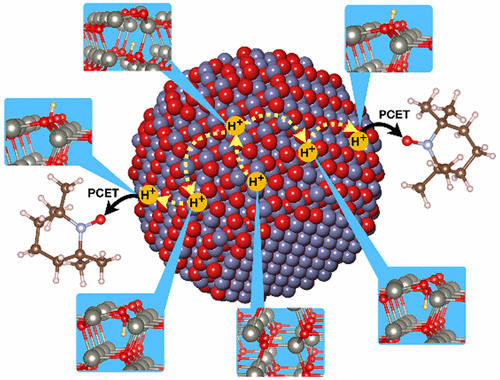Our official English website, www.x-mol.net, welcomes your
feedback! (Note: you will need to create a separate account there.)
Role of Proton Diffusion in the Nonexponential Kinetics of Proton-Coupled Electron Transfer from Photoreduced ZnO Nanocrystals
ACS Nano ( IF 15.8 ) Pub Date : 2017-09-22 00:00:00 , DOI: 10.1021/acsnano.7b05009 Soumya Ghosh 1 , Alexander V. Soudackov 1 , Sharon Hammes-Schiffer 1
ACS Nano ( IF 15.8 ) Pub Date : 2017-09-22 00:00:00 , DOI: 10.1021/acsnano.7b05009 Soumya Ghosh 1 , Alexander V. Soudackov 1 , Sharon Hammes-Schiffer 1
Affiliation

|
Experiments have suggested that photoreduced ZnO nanocrystals transfer an electron and a proton to organic radicals through a concerted proton-coupled electron transfer (PCET) mechanism. The kinetics of this process was studied by monitoring the decay of the absorbance that reflects the concentration of electrons in the conduction bands of the nanocrystals. Interestingly, this absorbance exhibited nonexponential decay kinetics that could not be explained by heterogeneities of the nanoparticles or electron content. To determine if proton diffusion from inside the nanocrystal to reactive sites on the surface could lead to such nonexponential kinetics, herein this process is modeled using kinetic Monte Carlo simulations. These simulations provide the survival probability of a proton hopping among bulk, subsurface, and surface sites within the nanocrystal until it reaches a reactive surface site where it transfers to an organic radical. Using activation barriers predominantly obtained from periodic density functional theory, the simulations reproduce the nonexponential decay kinetics. This nonexponential behavior is found to arise from the broad distribution of lifetimes caused by different types of subsurface and surface sites. The longer lifetimes are associated with the proton becoming temporarily trapped in a subsurface site that does not have direct access to a reactive surface site due to capping ligands. These calculations suggest that movement of the protons rather than the electrons dominate the nonexponential kinetics of the PCET reaction. Thus, the impact of both bulk and surface properties of metal-oxide nanoparticles on proton conductivity should be considered when designing heterogeneous catalysts.
中文翻译:

质子扩散在光还原ZnO纳米晶体中质子耦合电子转移的非指数动力学中的作用
实验表明,光还原的ZnO纳米晶体通过协调的质子耦合电子转移(PCET)机制将电子和质子转移至有机自由基。通过监测反映纳米晶体导带中电子浓度的吸光度衰减来研究此过程的动力学。有趣的是,这种吸光度表现出非指数衰减动力学,这不能用纳米粒子的异质性或电子含量来解释。为了确定质子从纳米晶体内部扩散到表面上的反应位置是否会导致这种非指数动力学,本文使用动力学蒙特卡洛模拟对这一过程进行了建模。这些模拟提供了质子在大块,地下,和纳米晶体中的表面位点,直到到达反应性表面位点,再转移到有机基团上。使用主要从周期密度泛函理论获得的激活势垒,模拟再现了非指数衰减动力学。发现这种非指数行为是由于不同类型的地下和地面位置引起的寿命的广泛分布而引起的。较长的寿命与质子变得暂时捕获在由于配位体封端而不能直接进入反应性表面位点的亚表面位点有关。这些计算表明质子而不是电子的运动主导了PCET反应的非指数动力学。因此,
更新日期:2017-09-23
中文翻译:

质子扩散在光还原ZnO纳米晶体中质子耦合电子转移的非指数动力学中的作用
实验表明,光还原的ZnO纳米晶体通过协调的质子耦合电子转移(PCET)机制将电子和质子转移至有机自由基。通过监测反映纳米晶体导带中电子浓度的吸光度衰减来研究此过程的动力学。有趣的是,这种吸光度表现出非指数衰减动力学,这不能用纳米粒子的异质性或电子含量来解释。为了确定质子从纳米晶体内部扩散到表面上的反应位置是否会导致这种非指数动力学,本文使用动力学蒙特卡洛模拟对这一过程进行了建模。这些模拟提供了质子在大块,地下,和纳米晶体中的表面位点,直到到达反应性表面位点,再转移到有机基团上。使用主要从周期密度泛函理论获得的激活势垒,模拟再现了非指数衰减动力学。发现这种非指数行为是由于不同类型的地下和地面位置引起的寿命的广泛分布而引起的。较长的寿命与质子变得暂时捕获在由于配位体封端而不能直接进入反应性表面位点的亚表面位点有关。这些计算表明质子而不是电子的运动主导了PCET反应的非指数动力学。因此,











































 京公网安备 11010802027423号
京公网安备 11010802027423号